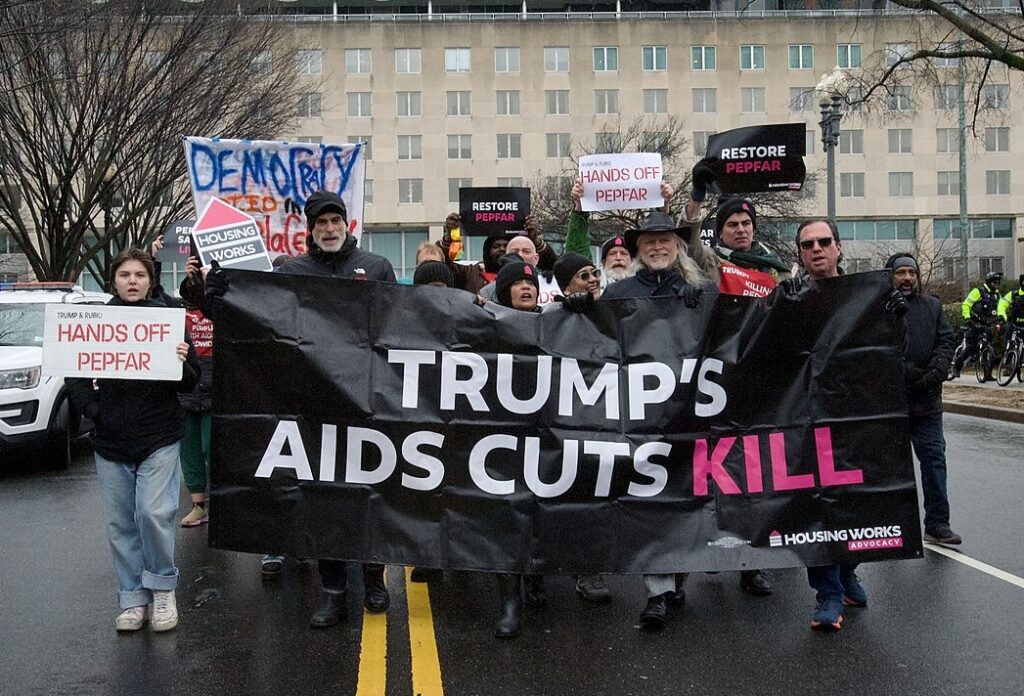The devastation that President Trump and Health and Human Services Secretary Robert F. Kennedy Jr. have visited on medical and other scientific research as well as public health programs has been well-documented, here and elsewhere. But could they bring back a nightmare that killed and traumatized too many in San Francisco and around the world?
That nightmare, of course, is rampant HIV/AIDS and the answer is yes, they could. And it sure seems like they’re trying, both in the U.S. and abroad.
It’s a complicated, ever-changing picture. Since the administration took office, it has implemented draconian cuts to HIV/AIDS research, prevention, and foreign aid. On top of this, the recently passed budget reconciliation bill includes massive cuts to Medicaid (called Medi-Cal in California) that could cut many off from health coverage and treatment. Some funding that theoretically still exists has been delayed. And while a portion of the cuts have been fully or partially reversed, often under court order, reality on the ground frequently doesn’t seem to match what’s officially been announced or ordered, and the picture keeps shifting. Meanwhile, Trump’s proposed budget for the 2026 fiscal year would, if adopted, continue the wave of destruction.

This grim and confusing situation quickly provoked howls of outrage from HIV/AIDS organizations nationwide, including the San Francisco AIDS Foundation, but the administration shows no signs of listening to those actually in the trenches trying to keep people healthy. And it’s a startling reversal from the first Trump administration, which in 2019 launched a well-regarded Ending the HIV Epidemic initiative. As soon as it became clear earlier this year that this effort was in danger, groups like AmFAR rallied behind it, to no apparent avail.
Treatment Action Group Executive Director Mark Harrington, whose history in AIDS activism goes back to the dark days of the 1980s, says bluntly, “All the cuts to NIH, USAID, and PEPFAR, as well as staffing cuts at CDC, have irreparably damaged the domestic and international HIV prevention, treatment, and research programs.” Overall, according to CDC Alumni and Friends, thousands of CDC staffers have been fired while about 450 of those firings have been rescinded—with further cuts proposed for next year.
Domestically, among the administration’s first casualties were a variety of HIV prevention programs. Funding for HIV prevention and testing destined for state and local health departments, as well as community-based organizations that had already been approved for the 2025 fiscal year, got held up. According to Rachel Klein, deputy executive director of The AIDS Institute, funds that were supposed to reach health departments June 1 did eventually go out a month late, and the restoration of these funds got a bit of press attention, but community groups did not get their funds at the same time, putting them under tremendous stress. The fate of many of those dollars remains uncertain and the upshot has been what Klein calls “confusion in the whole world of HIV prevention.”
If the administration’s proposed 2026 budget (discussed in more detail below) goes through, even the now-restored funding will eventually disappear. And the atmosphere of confusion and uncertainty does damage even when the dollars eventually come through. If an organization doesn’t know what funds it will have or whether they will arrive on schedule, planning for programs and hiring the necessary staff becomes nearly impossible.
An array of HIV testing, outreach and surveillance grants, many targeting rural communities, were squelched altogether, largely in conjunction with drastic staff cuts at the Centers for Disease Control and Prevention. NASTAD, an association of state and local health department staff working on HIV and hepatitis, said in June that the combination of delays and outright cuts put “HIV prevention efforts in crisis.”
The shifting picture has caused confusion and worry among all involved. Oni Blackstock, M.D., M.H.S., a primary care and HIV physician and executive director of Health Justice (and also, for the record, a fellow member of Defend Public Health) says, “It’s been confusing and cuts so far seem to be inconsistent.” Los Angeles, for example, experienced funding delays that Blackstock says New York City did not.
Blackstock adds, “I can personally speak about the CDC Division of HIV Prevention’s Let’s Stop HIV Together campaign on which I served as Clinical Ambassador for the last four years… the campaign reached communities and providers across the country through social media, live and virtual events, podcasts, and digital content. It really had an impact. Last month, I received an email saying that the program was terminated.”
While the dust hasn’t settled and some specifics will undoubtedly continue to shift, HIV prevention efforts will clearly have considerably less federal support going forward.
TREATMENT AND CARE IN DANGER
It’s not just HIV prevention being gutted. A variety of care and treatment programs are in danger, either from direct cuts or from Kennedy’s proposed reorganization of the Department of Health and Human Services that advocates fear will leave a trail of wreckage. Kennedy’s plan would drastically cut the number of agencies within HHS and move some of their functions into a new “Administration for a Healthy America.”
Klein calls the proposed reorganization “pretty extreme,” and when details of the administration’s proposed 2026 budget, which incorporates the reorganization scheme, came out in April, the American Academy of HIV Medicine wrote that it would “decimate offices and divisions across HHS and eliminate many programs, including the Centers for Disease Control and Prevention’s Division of HIV Prevention, Ending the Epidemic funding, Part F of the Ryan White HIV AIDS Program, Minority AIDS Initiative Funding, and a significant amount of the Substance Abuse and Mental Health Services Administration’s substance use treatment programs.”
While advocates generally say they’re open to a thoughtful conversation about whether HIV/AIDS programs might be reorganized, they say there’s been no dialogue or consultation, and that RFK Jr.’s proposed changes make little sense.
Because many of the existing agencies and programs were authorized by Congress, under the Constitution they can’t be eliminated without congressional authorization. But, Klein notes, Trump has often simply ignored such constitutional requirements and – as his ongoing dismantling of the Department of Education has illustrated – the Supreme Court has generally been willing to let him.
Meanwhile, in a move that advocates and clinicians found puzzling, HHS announced that by next June the National Institutes of Health would phase out its support of federal HIV clinical guidelines, vaguely suggesting that the responsibility might be transferred to another agency within HHS. Harrington blasted the decision as “another stupid and pointlessly destructive act with no possible rationale and no reason to transfer responsibility for something already being incredibly well-run to another entity which lacks relevant staff, experience, or qualifications to do this work.”
The final shape of many programs will be decided in the spending bills Congress passes over the next couple of months, bills that will either make real or change the drastic cuts and reshuffling that the administration’s FY 2026 budget proposes. Blackstock comments:
“With the proposed elimination of the CDC’s Division of HIV Prevention and Housing Opportunities for Persons with AIDS (HOPWA) program along with the proposed consolidation of other HIV-related funding/programs, we risk losing situational awareness of the epidemic (i.e., no program monitoring trends in new diagnoses, which communities are being impacted) and a sharp increase in new diagnoses because of reduced funding for testing, PrEP (pre-exposure prophylaxis), and other prevention services. Also, before this administration came into office, we had seen what I’ve called a ‘browning’ of the epidemic, with larger proportions of people with new diagnoses, being Black or Latinx. I suspect these cuts will hurt communities already made vulnerable to HIV.”
While the administration’s proposed budget does include $165 million for the vital HIV care services provided under the Ryan White Program and $157 million for PrEP in community health centers in support of Ending the HIV Epidemic activities, it would finalize the decimation of most HIV prevention programs.
“Maintaining funding for the Ending the HIV Epidemic initiative, which only focuses on 57 distinct geographic areas, while eliminating nearly $800 million for our nationwide surveillance, testing, education and outreach programs is a recipe for disaster,” commented Carl Schmid, executive director of the HIV+Hepatitis Policy Institute in an early June statement.
Even before 2026 budget decisions get finalized, the recently-passed reconciliation bill set in motion drastic changes to Medicaid, which will do great harm to people with HIV. As KFF has noted, Medicaid covers 40% of non-elderly adults with HIV, a far higher proportion than of the overall population, and is the largest single source of government funding for HIV care in the U.S. The work requirements—which advocates have noted are more accurately described as paperwork requirements designed to thin the rolls by creating bureaucratic obstacles to enrollment – and funding cuts are expected to have devastating effects as they kick in over the next two years.
Blackstock and other advocates are far from giving up, though. “It’s a scary time,” she says, “but it also isn’t new; we have been here before, in some ways. If there is any community that can navigate crisis, it’s the HIV community.” That will include efforts to lobby Congress to try to reduce the damage, but given how this Republican-dominated Congress has largely done Trump’s bidding, that may be an uphill fight. So Blackstock says the HIV community must “think about how we can support our HIV prevention and treatment outside of institutions—for example, mutual aid, community led-care, etc.”
For people of a certain age, that sounds an awful lot like 1983.
RESEARCH FACES THE AX
A vast array of scientific and medical research funded by the National Institutes of Health and the National Science Foundation has been cut, with yet more cuts proposed for 2026, including a significant amount related to HIV/AIDS. The administration has also moved to end—sometimes abruptly, killing studies that were already underway—a great deal of LGBTQ-focused health research that could have implications for HIV prevention and treatment.
Back in March, the administration cancelled dozens of HIV-related studies, in what HIV Medicine Association Chair Dr. Colleen Kelley termed “pure chaos and insanity” in an interview with CNN. “It’s just a massive, massive bloodbath.”
As 48 Hills has previously reported, some of these studies were squelched as a result of the administrations war against diversity, equity, and inclusion. These include not just LGBTQ-focused research, but anything dealing with marginalized groups or those who might face discrimination. Researchers received snide letters scolding them for doing research that was “antithetical to the scientific inquiry”—a claim that experts quickly slammed as ludicrous.
Harrington of the Treatment Action Group finds these sorts of cuts alarming. “The cuts related to research on LGBTQI+ people, Blacks, Latinx people, migrants, prisoners, and other groups highly affected by HIV, TB, and / or HCV are of greatest concern to TAG,” he says. “We are likely to lose access to information about health outcomes for groups particularly susceptible to poor health outcomes, including vis-a-vis HIV, HCV, and TB. Rising health disparities are likely with high costs in health and lives.”
As with many of the early Trump cuts to previously-approved funding, some grant recipients did eventually get funding restored, often as a result of litigation. But those whose terminations were a result of the administration’s war on mentions of gender identity seem to have all received letters restoring their funding but containing this stipulation, shared with me by one such grant recipient: “Recipient is compliant with Title IX of the Education Amendments of 1972, as amended, 20 U.S.C. §§ 1681 et seq., including the requirements set forth in Presidential Executive Order 14168 titled Defending Women From Gender Ideology Extremism and Restoring Biological Truth to the Federal Government, and Title VI of the Civil Rights Act of 1964, 42 U.S.C. §§ 2000d et seq., and Recipient will remain compliant for the duration of the Agreement.”
In other words, they must agree to the commandment that thou shalt not speak of transgender or nonbinary people or acknowledge their existence in any way. It’s too early yet to know how organizations and researchers are responding to this demand.
In another widely condemned move, RFK Jr., a notorious antivaxxer, has targeted research on HIV vaccines, shutting down a wide swath of vaccine studies. And it looks like future HIV vaccine funding will be strangled as well. CBS reported, “One senior NIH official said the HHS had also instructed the agency not to issue any more funding in the next fiscal year for HIV vaccine research, with only a small handful of exceptions.”
Researchers warned that the wave of cuts wouldn’t just impact the specific studies cancelled but would ripple through the entire HIV vaccine research effort, driving scientists from the field because their HIV work can’t get the funding needed to sustain it.
When asked about the HIV vaccine study cancellations in a June congressional hearing, Kennedy was dismissive, saying, “We’ve been studying and promising an HIV vaccine since 1984, and every year Congress pours money into it and every year it accomplishes nothing,”
Harrington retorts, “As with all his destructive activities related to vaccines of any kind, he’s wrong about HIV vaccine research, which is vital, and which has been making significant progress over the past 20 years, with spillover benefits for other disease such as COVID-19, Ebola, Marburg, et al., where the HIV vaccine basic science provided a platform for very rapid development and deployment of safe, effective vaccines for these diseases.”
DEATH AND SUFFERING OVERSEAS
One of the first targets of the Trump-Elon Musk budget-cutting ax was foreign aid—aid that provides food and medical care, including HIV/AIDS care, to some of the world’s poorest people. That has, at least to some degree, included a program initiated by President George W. Bush that even his harshest critics concede was a major accomplishment: PEPFAR, the President’s Emergency Plan for AIDS Relief. This program is estimated to have saved a staggering 26 million lives.
PEPFAR’s road under Trump 2.0 has been bumpy, to say the least. Almost immediately upon taking office, the administration froze all distribution of life-saving anti-HIV medications, but then quickly rescinded the freeze after a public outcry. The State Department, which took over what’s left of U.S. foreign aid after Trump shut down the U.S. Agency for International Development, has maintained that life-saving PEPFAR care and treatment resources continue to flow.
But the cuts and uncertainty have caused real and deadly changes on the ground. PEPFAR has long covered PrEP, playing a crucial role in curbing HIV transmission in many countries that otherwise would never be able to afford these medications. When funding was restarted after the January freeze, the State Department only authorized PrEP to prevent mother-to-child transmission. Everyone else, including gay and bisexual men, sex workers and injection drug users, was left out, their deaths apparently considered acceptable.
In general, reality on the ground has often failed to match the State Department’s happy assessments, and cuts—though not a complete freeze—seem to still be in place. On June 19, the South African nonprofit news outlet Ground Up published a devastating story about “the children the United States left to die”—orphans with HIV in Mozambique.
Critical elements of the care these children received were paid for by USAID (mainly, but possibly not all, funded by PEPFAR) and vital resources were abruptly cut off and not restored. Ground Up describes the result:
“Hospitals run short of life-saving drugs. Doctors and nurses are laid off en masse. Hospital lines get longer and longer. Some patients are given the wrong medication, likely because the data capturers (who manage patient files) have lost their jobs. Community case workers who had been delivering HIV medication to orphaned children stop coming. Without their antiretrovirals (ARVs), some of these children die.”
A July United Nations report reflected both uncertainty and worry, noting:
“PEPFAR, for example, was supporting remuneration for at least 340 000 health workers, but it is not clear how many of these are still working. Also unclear is the full extent to which crucial services have been maintained or resumed, and their quality and reach. This is partly because the funding losses are also disrupting—and in some cases dismantling—data collection and management systems, which affects the capacity to track service interruptions and to respond appropriately.”
And it’s not just HIV care that has suffered. Tuberculosis is still regularly seen in Mozambique as well as in other African countries, and local leaders report an uptick in TB deaths.
One small bit of good news did happen recently: The administration’s rescission package, in which Congress at Trump’s request pulled back funds it had previously authorized for a variety of foreign aid programs as well as for public broadcasting, originally contained a $500 million cut to PEPFAR. Enough Senate Republicans objected that the White House agreed to remove the PEPFAR cut from the final bill that was eventually passed and signed into law.
Still, Harrington is not optimistic about the overall picture of foreign aid cuts and restrictions, saying the result will likely be that “millions of unnecessary new infections and deaths due to HIV and TB will occur unless these cuts are fully restored.”
At the moment, chances of that seem slim.




